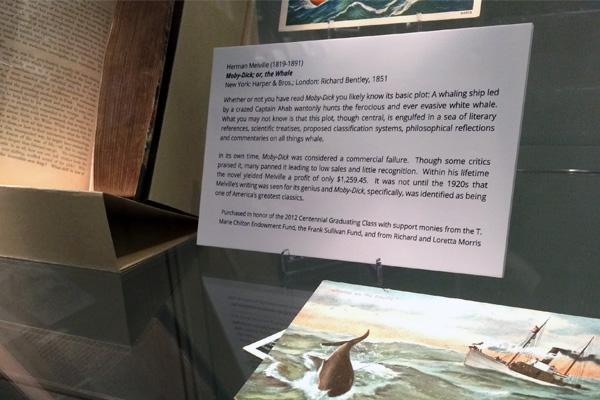
Like Ahab in the novel itself, we just can’t seem to shake our obsession with Moby-Dick, even 163 years after its publication.
Is it a book about whaling? Yes. Is it also a book about everything else? Yes, including science, religion, humanity’s place in the world, 19th century industrialization, and on and on. Does it remind English Professor Paul Harris of a Bollywood musical? Absolutely.
To celebrate and offer new insight into our neverending fixation on Herman Melville’s story of the white whale, the William H. Hannon’s Department of Archives and Special Collections created this semester’s exhibition, Moby-Dick: A Whale of a Text. The exhibition, curated by Digital Scholarship Librarian Melanie Hubbard, features artifacts from Melville’s time that have special significance for the book, such as writings on whaling, phrenology, and the then-uncommon practice of tattooing. It will remain on display through Dec. 12.
At the opening reception on Wednesday, Sept. 17, professors Carla Bittel of History, Jane Brucker of Studio Art, and Harris and Robin Miskolcze of English talked about the enigmatic novel and how their own teaching and research intersects with it.
For Bittel, the book’s evocation of phrenology—an outdated belief that the shape of one’s skull reflects personality and moral traits—dovetailed with her own research into the history of medicine and science. “Moby-Dick is in an engagement with with the sciences with a skeptical eye, through both the narrator Ishmael and Melville himself,” she said.
Miskolcze found in Ahab’s maniacal hunt an attempt to know himself, but also a self-fulfilling prophecy, started when his mother named him after a Biblical king who worshipped false gods and ignored prophecies of his own doom. “Moby-Dick, for Ahab, is more than just a whale,” Miskolcze noted.
Bruckner asked students in her Visualizing Literature class this semester to create works inspired by Moby-Dick, which will be on display in the exhibition starting in November. Harris compared it to an Indian film extravaganza, noting the long build-up to a big event in the last few moments (in the novel, its climactic battle; in the typical Bollywood movie, an elaborate wedding).
But what of the novel’s own unusual place in history? It was poorly regarded upon its publication and virtually forgotten for generations, only to be rehabilitated beginning in the 1920s and is now considered one of the greatest works of its era. While everyone had some thoughts, there no easy answers.
“Every time I see how many people are hooked into reading this book, it’s very gratifying,” Harris said.



